Wheeling Suspension Bridge
Introduction
Text-to-speech Audio
Images
View from the Wheeling Suspension Bridge, 1977. Photo taken from City of Wheeling side, looking West toward Wheeling Island.
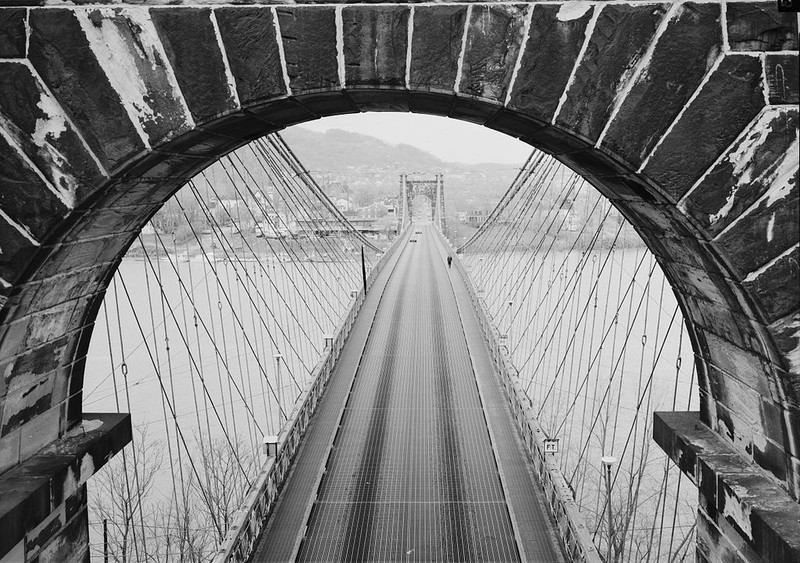
View of the Wheeling Suspension Bridge from Virginia Street.
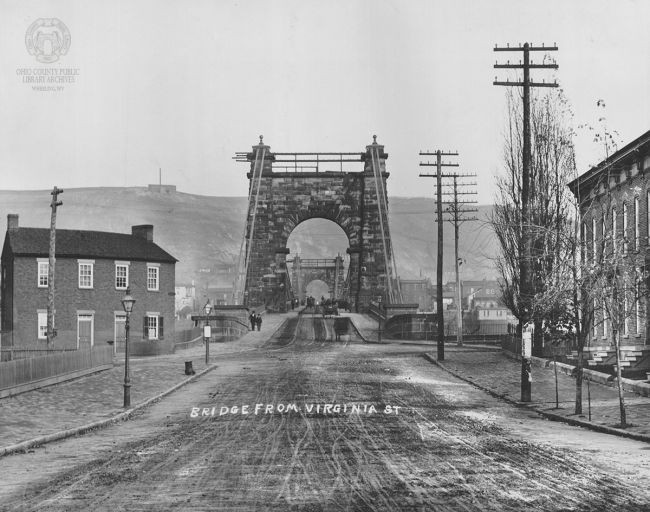
Wheeling Suspension Bridge historical marker.
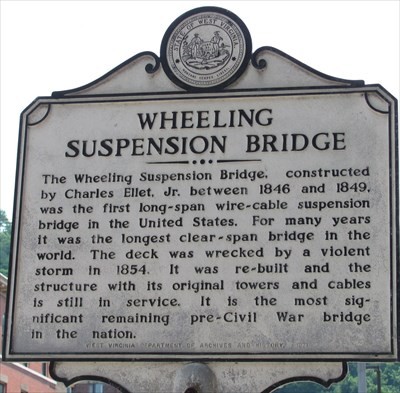
Oldest known photo of the Wheeling Suspension Bridge. Notice the flooded Ohio River, photographed 1852. Notice flooded Wheeling Island at the end of the bridge. W.C. Brown Collection.
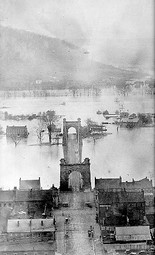
Wheeling Suspension Bridge view from Wheeling, 2018.

Walking the suspension bridge from Wheeling Island to the city of Wheeling.
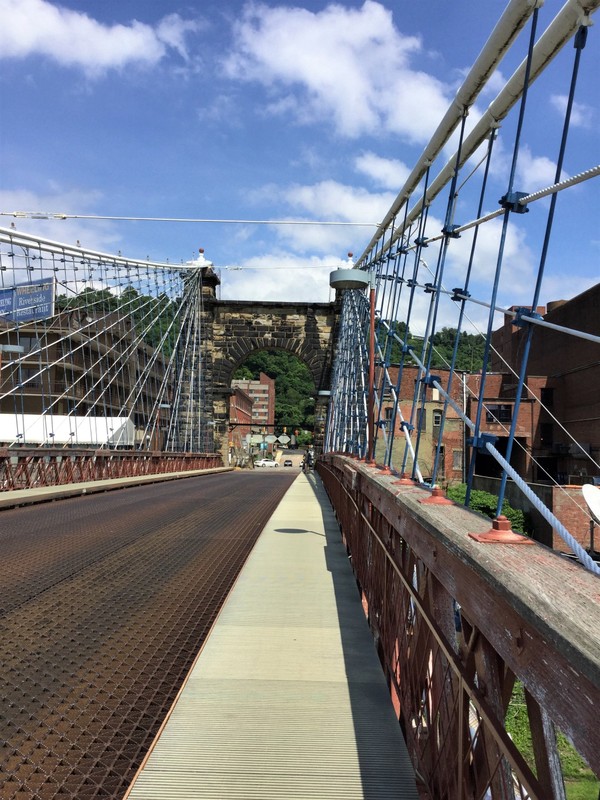
Visitors crossing the suspension bridge into Wheeling see this sign, a reference to the country music radio show first broadcast in 1933 on 1170 am. This 50,000 watt station that covered most of the country east of the Mississippi.
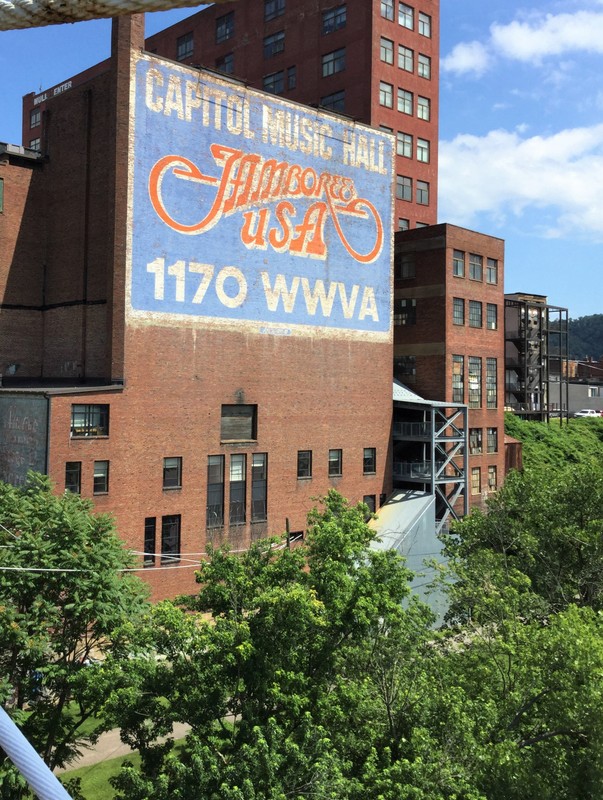
A view of Wheeling Island from the bridge, looking across the Ohio River.
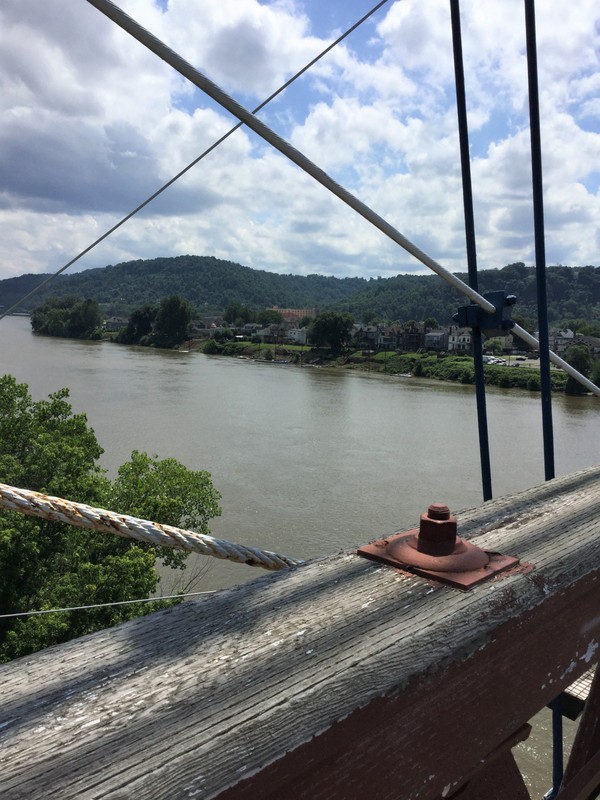
Backstory and Context
Text-to-speech Audio
After a rivalry between Pittsburgh and Wheeling to become the city to bridge the Ohio River, a charter was granted to the Wheeling and Belmont Bridge Company in 1816. This charter was to construct a bridge to extend the Cumberland Pike, which was to be completed in 1818, to Ohio. After some delays and opposition, a new bridge charter was obtained in 1847. Charles Ellet and John A. Roebling were invited to submit designs and estimates for a bridge over the east channel of the river to Wheeling Island. In doing so, the design was set as a suspension bridge, as Ellet and Roebling were the foremost authorities on the topic. Ellet received the contract award in 1847 and began the same year. The bridge was completed in 1849.
"The firing of cannon continued for a great portion of the day, and the crowds along the Bridge sensibly increased until 3 o'clock, when the ladies assembled, and with their escorts passed over to the Island and returned. With them the hour seemed given up to enjoyment, friend met friend, and gaiety and good feeling reigned supreme. We had there the pleasure of meeting more lovely and happy faces than we have seen before for months. A continuous train of human beings moved along the work from 3 o'clock until dark.
At 6 o'clock, the thousand lamps, hung up on the wires, were lighted almost simultaneously and presented an elegant and graceful curve of fire, high above the river, that was never excelled in beauty. It forcibly reminded one of Mr. Clay's remarks, a few days since, when looking at the work from a distance, while his face glowed with pride and exultation — "Take that down! you might as well try to take down the rainbow."2 - The Daily Wheeling Gazette, Nov. 17, 1849
The span of the bridge is 1010 feet, measured from the center of the two supporting towers – the longest clear-span bridge in the world at the time. All materials for the bridge, including the drawn iron wire used to create the cables, were produced locally. The main cables rest upon iron rollers at the summits of each tower. The rollers relieve the strain on the cables caused by expansion and contraction with changes in temperature.
In 1854, high winds set up an oscillation in the deck structure that resulted in severe damage to the bridge. Once again, Pittsburgh rivaled Wheeling for the reconstruction of the bridge. The Wheeling Bridge Case went to the Supreme Court and lasted from 1854 to 1856 with a judgment in favor of Wheeling.
Under the supervision of Ellet, reconstruction work began almost immediately and the bridge was reopened in just three months. In 1867, the Citizen Railway Company was granted permission to lay tracks on the bridge to accommodate horse-drawn streetcars; a possibility indicated earlier by Ellet. In 1872, Washington Roebling, son of John Roebling, was commissioned to provide upgrades to the bridge which included the installation of the diagonal cable stays. The bridge remained essentially unchanged until 1956 when a new steel deck system was installed.
The most recent work on the bridge was completed in 1999 with repairs to the stiffening truss and wire rope stays, complete inspection and re-wrapping of the cables, and the installation of new illumination. Today, the bridge stands as one of the finest examples of pre-Civil War engineering and is considered as one of the world’s most significant and historic bridges. Wheeling and the Suspension Bridge is home to one of the greatest engineering achievements in American History. The nearly 170-year-old Wheeling Suspension Bridge is the oldest operating suspension bridge in the world. The bridge was the first to span a main channel of the Ohio River. In 1836, a two-span covered bridge opened over the back channel of the Ohio in Wheeling. This bridge crossed at the site of an 1893 truss and modern day bridge that carries Route 40 over the back channel to this day.
Cite This Entry
Marshall University et. al. "Wheeling Suspension Bridge." Clio: Your Guide to History. October 5, 2020. Accessed April 22, 2025. https://theclio.com/entry/26941
Sources
1. “Wheeling Suspension Bridge.” Accessed October 18, 2016. http://www.wvculture.org/history/transportation/wheelingbridge02.html. 2. Ohio County Public Library. “Wheeling History > Suspension Bridge: Opening Ceremonies, 1849.” 2016. Accessed October 18, 2016. http://www.ohiocountylibrary.org/wheeling-history/ceremonies-opening-the-wheeling-suspension-bridge-1849/3306. 3. "The National Road: West Virginia - Wheeling Suspension Bridge." The National Road: West Virginia - Wheeling Suspension Bridge. N.p., n.d. Web. 08 Dec. 2015. .

